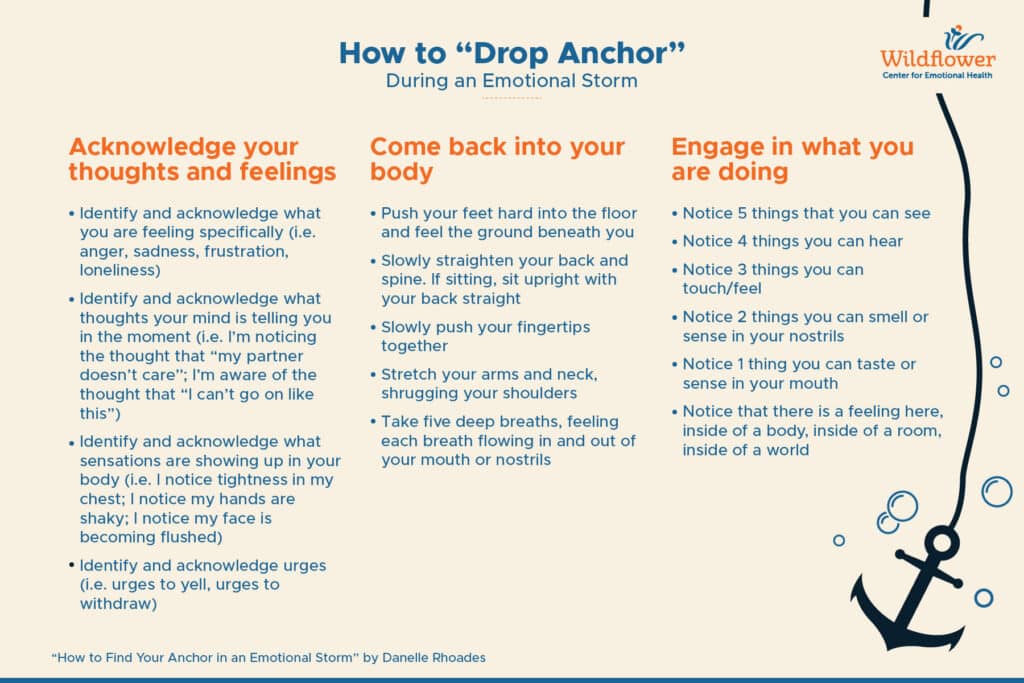 Have you ever had a time where your thoughts and feelings have gotten the best of you? Take this for example: You arrive home from work and you see your partner after a long day. You say “Hi honey!” to them, and they don’t respond (not even a nod)!
Have you ever had a time where your thoughts and feelings have gotten the best of you? Take this for example: You arrive home from work and you see your partner after a long day. You say “Hi honey!” to them, and they don’t respond (not even a nod)!
How might you react? You may think: “Geeze, do they even care about me? They didn’t even say hi or ask how MY day was! What a jerk.”
How might you feel if these thoughts pop up? Angry? Sad? Disappointed? Hurt? And how might you act in that moment with all those thoughts and feelings swirling around? Would you yell at your partner, accuse them of not caring about you, withdraw from them, plan for revenge by telling yourself “Tomorrow, I’m not going to acknowledge THEM after we get home, see how they like it.”
From an Acceptance and Commitment Therapy (ACT) perspective, the reactions above (while they may not ring true to you specifically), can be understood given the context (Harris, 2009). However, while yelling, withdrawing, and planning revenge may help us feel “better” in the moment, I can imagine long-term this would likely lead to some serious discord in the relationship!
This is a core assumption in ACT – that all behavior makes sense given the context, and that humans are particularly skilled at avoiding pain, such as the pain of your partner not acknowledging you (Harris, 2009). And that makes sense too! After all, our minds, bodies, and genes have been shaped by evolutionary forces to ensure our survival by avoiding both physical and psychological pain as much as possible (Harris, 2007). However, while we can learn not to touch a stove when it gets too hot, we can’t always avoid situations in which we feel disappointment, sadness, anger, or worry. Well, we can try, but what kind of life would that be?
The point is, human beings have been wired to cope and respond to psychological pain in ways that attempt to diminish, avoid, stop, and control it (Harris, 2007). However, humans are complex beings, and research has shown that attempts to avoid psychological pain are typically unhelpful and can lead us to live a life dictated and controlled by our thoughts and feelings, rather than what truly matters to us, deep in our hearts (Harris, 2007).
So what can we do? Acceptance and Commitment therapy has adapted a strategy called “Dropping Anchor,” which is meant to provide support in noticing all aspects of the present moment, without judgment. In a sense, it is designed to help ground you when you are caught up in a painful emotional storm, pulled away from what is happening right in front of you. While this strategy isn’t supposed to get rid of painful thoughts and feelings, it can certainly support us in becoming more aware of what’s happening inside our bodies and minds, and assist us in taking action that feels aligned with the person we want to be.
You can use the acronym ACE to guide you in this practice:

Acknowledge your thoughts and feelings
- Identify and acknowledge what you are feeling specifically (i.e. anger, sadness, frustration, loneliness)
- Identify and acknowledge what thoughts your mind is telling you in the moment (i.e. I’m noticing the thought that “my partner doesn’t care”; I’m aware of the thought that “I can’t go on like this”)
- Identify and acknowledge what sensations are showing up in your body (i.e. I notice tightness in my chest; I notice my hands are shaky; I notice my face is becoming flushed)
- Identify and acknowledge urges (i.e. urges to yell, urges to withdraw)
Come back into your body
- Push your feet hard into the floor and feel the ground beneath you
- Slowly straighten your back and spine. If sitting, sit upright with your back straight
- Slowly push your fingertips together
- Stretch your arms and neck, shrugging your shoulders
- Take five deep breaths, feeling each breath flowing in and out of your mouth or nostrils
Engage in what you are doing
- Notice 5 things that you can see
- Notice 4 things you can hear
- Notice 3 things you can touch/feel
- Notice 2 things you can smell or sense in your nostrils
- Notice 1 thing you can taste or sense in your mouth
- Notice that there is a feeling here, inside of a body, inside of a room, inside of a world
If you’re like me and would find it helpful to have a guide to walk you through these steps, there are recordings available through this link (Harris, 2021).
In summary, while this strategy is not meant to get rid of psychological pain, it can be useful in helping you connect to what matters amidst an emotional storm. Most people find it especially effective if practiced when feeling calm so as to become accustomed to utilizing this new approach in relating to our painful thoughts and feelings when an emotional storm arises.
![]()
References
Harris, R. (2007). The happiness trap: How to stop struggling and start living. Boulder, CO: Shambhala Publications.
Harris, R. (2009). ACT made simple: A quick start guide to ACT basics and beyond. Oakland, CA: New Harbinger Publications, Inc.
Harris, R. (2021, November 30). Act mindfully workshops with Russ Harris. Free Audio.
![]()
Wildflower Center for Emotional Health is a therapy practice with offices in Chicago (River North) and Oak Park, IL. We offer in-person services at each of our locations as well as online therapy to anyone in Illinois. We specialize in perinatal and reproductive health, trauma and PTSD, anxiety and depression, relationships, sex and intimacy concerns, and more.Learn More

